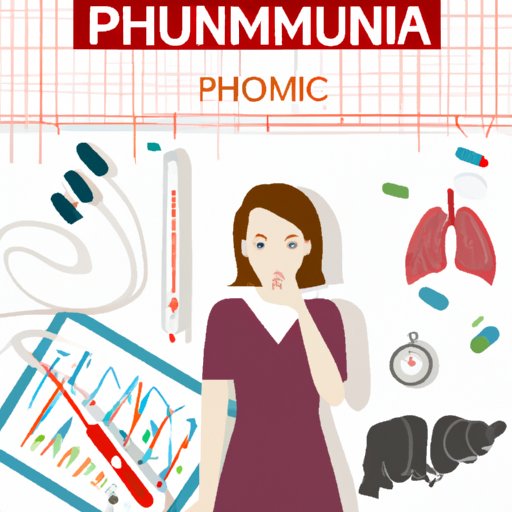
Introduction
Pneumonia is a serious illness that can affect people of any age, but it is most common in the elderly and young children. It is a condition that can develop quickly and without warning. The primary role of the lungs is to provide oxygen to the blood, but when they become infected, they cannot perform their function, and breathing becomes challenging. Early detection and timely diagnosis of pneumonia are crucial to prevent further complications.
Unexpected Symptoms: How to Identify Pneumonia without a Cough
While coughing is the most common symptom of pneumonia, it is not the only one. Atypical pneumonia, which is caused by bacteria such as Legionella, Mycoplasma, and Chlamydia, can present with unusual symptoms.
Common causes of atypical pneumonia
The atypical form of pneumonia is often caused by bacteria that do not show up on a chest x-ray. These bacteria are difficult to detect and can resist standard antibiotics. The most common causes of atypical pneumonia are:
- Legionella pneumophila
- Mycoplasma pneumonia
- Chlamydia pneumonia
Symptoms other than cough that may indicate pneumonia
Here are some unexpected symptoms that may indicate the presence of pneumonia:
Shortness of breath
Difficulty breathing or shortness of breath is a common symptom of pneumonia. It happens when the lungs and air sacs are filled with fluid and pus. The air sacs cannot fill up with air, causing a reduced flow of oxygen to the body cells.
Fever
Fever is common in pneumonia patients. It’s the body’s natural response to fight infection, and it may last from a few days to several weeks.
Chest pain
Chest pain is a symptom of several respiratory illnesses, including pneumonia. It occurs when the lining surrounding the lungs becomes inflamed. The pain may range from mild to severe, and it can be felt on one or both sides of the chest.
Rapid heartbeat
When pneumonia affects the lungs, the heart may work harder to provide oxygen to the body cells, leading to a rapid heartbeat.
Fatigue
Fatigue is a common symptom of pneumonia that is often overlooked. The body is working hard to fight the infection, so it’s common to feel tired all the time.
Silent Indicators: Tips to Recognize Pneumonia Before it Gets Worse
Risk factors for developing pneumonia
Everyone is susceptible to pneumonia, but some people are at higher risk. The following groups have a higher risk of developing pneumonia:
- Infants and young children
- Elderly individuals
- People with weakened immune systems
- Smokers
- People with chronic lung diseases
Importance of regular check-ups and monitoring of symptoms
Regular check-ups with a medical professional are crucial to identify early symptoms of pneumonia. Healthcare professionals can detect symptoms early and improve the likelihood of successful treatment.
Methods to detect early signs of pneumonia
People should monitor their symptoms and seek medical attention if they suspect pneumonia. Healthcare providers can use blood tests, chest X-rays, and CT scans to diagnose pneumonia. Early detection can increase the chances of successful treatment and prevent complications like sepsis and acute respiratory distress syndrome.
Beyond the Cough: Investigating Uncommon Signs of Pneumonia
Rare symptoms of pneumonia
Pneumonia can present with uncommon symptoms, and these can range from digestive problems to seizures. Some of the rare symptoms of pneumonia include:
- Nausea and vomiting
- Confusion or changes in mental awareness
- Headaches
- Seizures
- Sweating and clammy skin
Types of pneumonia that do not present with a cough
Some types of pneumonia do not present with a cough but cause other symptoms. These types include walking pneumonia, viral pneumonia, and atypical pneumonia.
Diagnosing and treating such rare cases
Diagnosis of rare forms of pneumonia may require more tests than the typical procedure. Healthcare professionals may prescribe specific antibiotics based on the type of bacteria, virus, or fungus causing pneumonia. Treatment may also include supplemental oxygen therapy, IV fluids, or mechanical ventilation.
Breaking the Stereotype: Pneumonia can exist without a Cough
Myths about pneumonia and coughing
Many people believe that coughing is the primary symptom of pneumonia. However, pneumonia can exist without a cough and can present with a different set of symptoms.
Clarifying common misconceptions
Pneumonia is a widespread respiratory illness that requires timely diagnosis and appropriate treatment. It is essential to understand the range of symptoms and develop a strategy that promotes early detection and treatment.
Early Detection: Identifying Pneumonia, Even Without a Typical Cough
Benefits of early detection
Early detection of pneumonia helps prevent further complications and can improve the chances of successful treatment.
Ways to prevent pneumonia
The following are some ways to prevent pneumonia:
- Getting vaccinated
- Practicing good hygiene, like washing hands regularly
- Avoiding close contact with infected individuals
- Quitting smoking
- Avoiding exposure to polluted air
Treatment options for pneumonia
Treatment options for pneumonia depend on the severity of the infection. They include:
- Antibiotics
- Antivirals
- Antifungals
- Steam inhalation
- Ventilator support
Conclusion
Recap of key points
Pneumonia is a respiratory illness that causes inflammation in the lungs and can develop quickly without warning. While coughing is the most common symptom of pneumonia, it is possible to have pneumonia without a cough. Early detection and timely diagnosis are crucial to prevent further complications.
Overall significance of understanding the symptoms of pneumonia without a cough
Understanding the symptoms of pneumonia without a cough is essential to prevent further complications and improve the chances of successful treatment.





